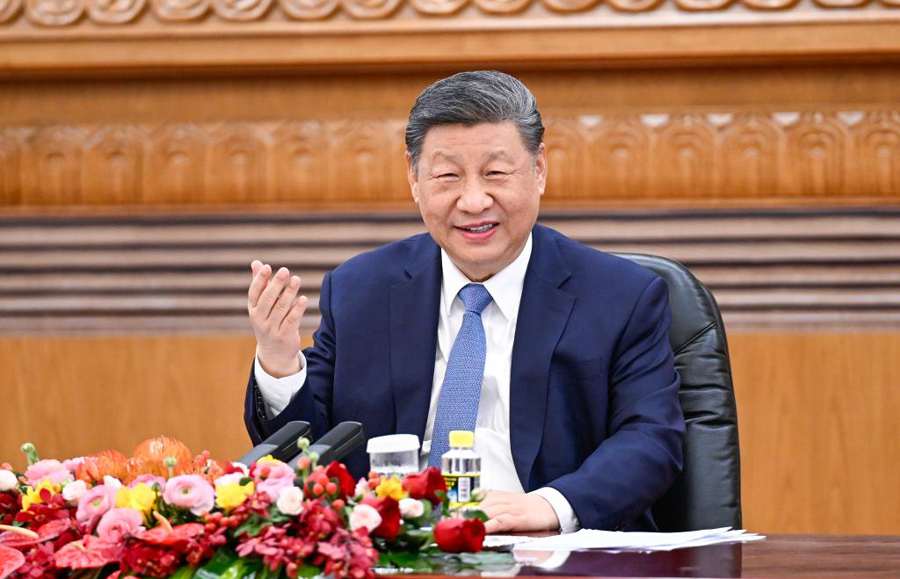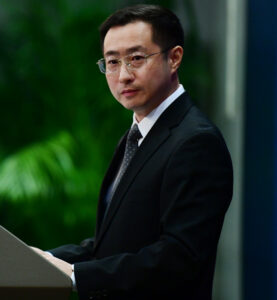
Chinese President Xi Jinping
Beijing/New York/Washington/Geneva: China today vowed to enact “resolute and strong measures” in response to the United States President Donald Trump’s threat to impose an additional 50 per cent tariff on Chinese imports unless Beijing dismantles its retaliatory levies by the close of today.
China today also initiated a dispute at the World Trade Organization (WTO) against the United States, challenging the imposition of “reciprocal tariffs.” The request for consultations, which was shared with WTO members on April 8, highlights US measures that impose a 10% additional duty on imports from all countries as of April 5, and a 34% additional duty on Chinese imports set to take effect on April 9. China argued that these tariffs violate the US’s commitments under several provisions of the General Agreement on Tariffs and Trade (GATT) 1994, the Agreement on Customs Valuation, and the Agreement on Subsidies and Countervailing Measures.

In Beijing, Chinese Foreign Ministry spokesperson Lin Jian unleashed a blistering critique, declaring, “America’s abuse of tariffs severely infringes on the legitimate rights and interests of other countries, violates the WTO rules, undermines the rules-based multilateral trading system, and impacts the stability of the global economic order.” He labelled it “a typical move of unilateralism, protectionism, and economic bullying,” widely opposed by the international community, and insisted, “Intimidation, threat, and blackmail are not the right way to engage with China.” Lin warns that if the U.S. presses forward, “China’s response will continue to the end.”
Trump’s demand intensifies his announcement on April 7, 2025, of tariff hikes targeting over 180 countries and regions, a move that has triggered widespread alarm. Lin highlighted the fallout, citing World Trade Organization (WTO) data analysis that shows these measures disproportionately burden less developed nations, widen the global wealth gap, and jeopardise the UN’s 2030 Sustainable Development Goals. In New York, UN Secretary-General spokesman Stéphane Dujarric cautioned that the trade war “will adversely affect implementation of Sustainable Development Goals,” with the most vulnerable economies least equipped to cope. In Geneva, WTO Director-General Ngozi Okonjo-Iweala adds that the U.S. tariffs could contract global merchandise trade volumes by 1 percent in 2025, carrying “substantial implications for global trade and economic growth prospects.”
China stands firm, with retaliation on the horizon. Lin sidesteps specifics when media persons pressed on countermeasures, stating, “We will not tolerate any attempt to harm China’s sovereignty, security, and development interests.”
Influential Chinese bloggers today posted identical lists of potential responses, including levies on U.S. farm goods, a ban on Hollywood movies, and four other unnamed steps. Lin shrugged these off as “what’s been said on the Internet,” but reaffirmed, “We will continue to take resolute measures to safeguard our legitimate and lawful rights and interests.” On LinkedIn, Dr. Wei Zhang, a Shanghai-based trade analyst, wrote today: “China’s response is not just rhetoric; it’s a calculated stand to protect a $17 trillion economy from external coercion.” Beijing economist Li Mei added: “Tariffs won’t break China’s supply chain dominance—it’s too entrenched globally.”
The U.S. zeroes in on China due to entrenched economic and strategic frictions. In 2024, the U.S. trade deficit with China hit $279 billion, per the U.S. Census Bureau, a figure down from its 2018 peak of $419 billion but still a thorn in Washington’s side. China’s role as the world’s manufacturing titan—producing 28.7 per cent of global goods, according to the UN Statistics Division—grants it unmatched leverage. Its grip on critical supply chains, such as rare earth elements, where it controls 60 per cent of production (U.S. Geological Survey), anchors U.S. industries from tech to defence. A 2023 U.S. Trade Representative report accuses China of intellectual property theft and state subsidies, charges Beijing refutes, fuelling Trump’s rationale for singling out China in his trade overhaul.
Trump’s tariff approach stirs further debate. Experts, as noted by Anadolu Agency, reveal that the U.S. calculates rates by dividing its trade deficit with a country by that nation’s exports to America, a method unmoored from actual tariffs and padded with claims of currency manipulation and trade barriers. Lin denounced this as a departure from 40 years of trade norms, asserting, “The U.S.’s tariff hikes on all trading partners, including China, under various pretexts seriously infringe upon the legitimate rights and interests of countries.” He contended it signals a U.S. bid to reshape the global economic order, a view shared by trade consultant James Carter from New York, who posts on LinkedIn today: “This isn’t reciprocity—it’s a power play that ignores how U.S. consumers rely on affordable Chinese imports.”
Talks seem distant. When inquired about dialogue, Lin responded, “Judging from its actions, the U.S. doesn’t seem to be serious about having talks right now,” insisting that negotiations demand “equality, respect, and mutual benefit.” On a question about conditions for talks or a Trump-Xi call elicited a referral to “competent authorities,” with Lin adding, “Pressuring or threatening China is not a right way to engage with us.” Tensions spike as Shenzhen TV cites U.S. Vice President JD Vance’s remark that the U.S. “borrows money from Chinese peasants to buy the things those Chinese peasants manufacture.” Lin retorted, “To hear words that lack knowledge and respect like those uttered by this Vice President is both surprising and kind of lamentable.”
The dispute spills over, ensnaring TikTok’s U.S. fate. Trump claims China’s tariff objections have stalled a deal to sell the app and sustain its American operations, prompting Lin to counter, “We have stated our principled position on TikTok on multiple occasions,” and demand the U.S. offer “an open, fair, just, and non-discriminatory environment” for Chinese firms. Lin ties this to China’s wider push for equity, urging nations to uphold the WTO-centric trading system and resist unilateralism. Yesterday, he told CCTV: “The U.S. hegemonic move in the name of ‘reciprocity’ serves its selfish interests at the expense of other countries’ legitimate interests,” a position he bolsters today with a call for true multilateralism.
China’s stance finds echoes globally. Lin noted yesterday that “the vast majority of countries in the world that uphold fairness and justice will choose to stand on the right side of history,” a sentiment reflected on LinkedIn by Mumbai-based analyst Priya Sharma today: “The Global South watches closely—China’s defiance could rally a bloc against U.S. overreach.” With Trump’s deadline upon us today, the stakes loom large. China’s $17 trillion economy, its supply chain prowess, and its determination to shield its development rights collide with a U.S. policy risking self-inflicted wounds. As Lin declares, “If the U.S. decides not to care about the interests of the U.S. itself, China, and the rest of the world, and is determined to fight a tariff and trade war, China’s response will continue to the end.” The world holds its breath as this showdown unfolds.
– global bihari bureau





